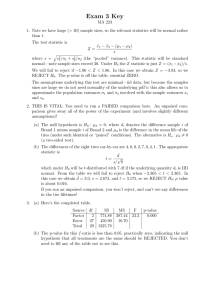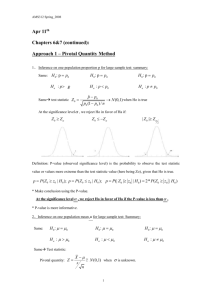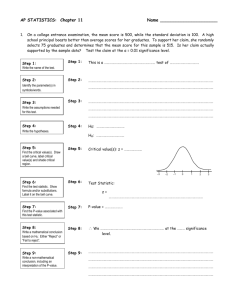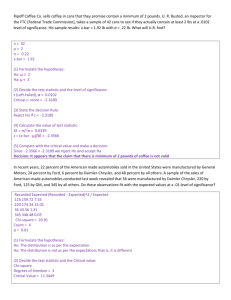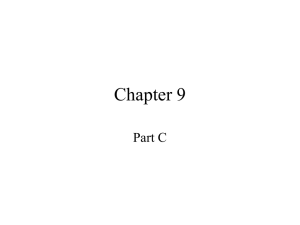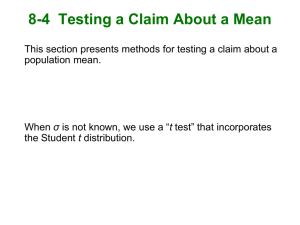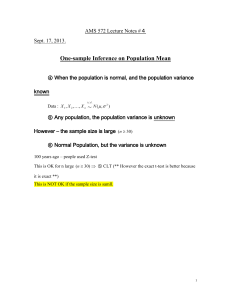9.54 Faced with rising fax costs, a firm issued a guideline that
advertisement
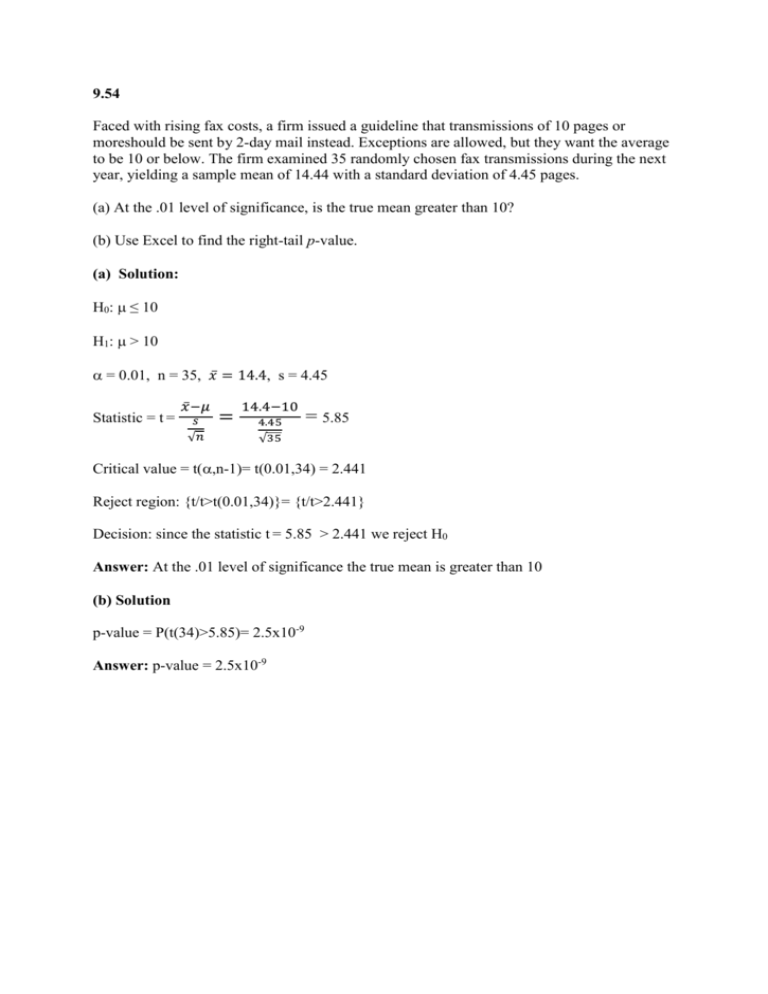
9.54
Faced with rising fax costs, a firm issued a guideline that transmissions of 10 pages or
moreshould be sent by 2-day mail instead. Exceptions are allowed, but they want the average
to be 10 or below. The firm examined 35 randomly chosen fax transmissions during the next
year, yielding a sample mean of 14.44 with a standard deviation of 4.45 pages.
(a) At the .01 level of significance, is the true mean greater than 10?
(b) Use Excel to find the right-tail p-value.
(a) Solution:
H0: ≤ 10
H1: > 10
= 0.01, n = 35, 𝑥̅ = 14.4, s = 4.45
Statistic = t =
𝑥̅ −𝜇
𝑠
√𝑛
=
14.4−10
4.45
√35
= 5.85
Critical value = t(,n-1)= t(0.01,34) = 2.441
Reject region: {t/t>t(0.01,34)}= {t/t>2.441}
Decision: since the statistic t = 5.85 > 2.441 we reject H0
Answer: At the .01 level of significance the true mean is greater than 10
(b) Solution
p-value = P(t(34)>5.85)= 2.5x10-9
Answer: p-value = 2.5x10-9
9.56 A coin was flipped 60 times and came up heads 38 times.
(a) At the .10 level of significance, is the coin biased toward heads? Show your decision rule
and calculations.
(b) Calculate a p-value and interpret it.
(a) Solution
H0: p ≤ 0.5
H1: p > 0.5
= 0.1, n = 60, x = 38, 𝑝̂ =
√
=
𝑝(1−𝑝)
𝑛
𝑛
=
19
−0.5
30
𝑝̂−𝑝
Statistic = z =
𝑥
0.5(1−0.5)
60
38
60
=
19
30
= 2.066
√
Critical value = z()= z(0.1) = 1.282
Reject region: {z/z>z(0.1)}= {z/z>1.282}
Decision: Since the statistic z = 2.066 > 1.282 we reject H0
Answer: At the 0.1 level of significance the the coin is biased toward heads
(b) Solution
p-value = P(Z>2.066) = 0.0194
Answer: p-value = 0.0194 is lower than the 0.1 level, so we reject the null hypothesis and
conclude again that the coin is biased toward heads
9.62 The Web-based company Oh Baby! Gifts has a goal of processing 95 percent of its
orders on the same day they are received. If 485 out of the next 500 orders are processed on
the same day, would this prove that they are exceeding their goal, using α = .025? (See
story.news.yahoo.com accessed June 25, 2004.)
Solution
H0: p ≤ 0.95
H1: p > 0.95
𝑥
485
= 0.025, n = 500, x = 485, 𝑝̂ = 𝑛 = 500 = 0.97
𝑝̂−𝑝
Statistic = z =
√
=
𝑝(1−𝑝)
𝑛
0.97−0.95
0.95(1−0.95)
500
= 2.052
√
Critical value = z()= z(0.025) = 1.96
Reject region: {z/z>z(0.025)}= {z/z>1.96}
Decision: Since the statistic z = 2.052 > 1.96 we reject H0
Answer: At the 0.025 level of significance we can say that they are exceeding their goal
9.64 An auditor reviewed 25 oral surgery insurance claims from a particular surgical office,
determining that the mean out-of-pocket patient billing above the reimbursed amount was
$275.66 with a standard deviation of $78.11.
(a) At the 5 percent level of significance, does this sample prove a violation of the guideline
that the average patient should pay no more than $250 out-of-pocket?
State your hypotheses and decision rule.
(b) Is this a close decision?
(a) Solution
H0: ≤ 250
H1: > 250
= 0.05, n = 25, 𝑥̅ = 275.66, s = 78.11
Statistic = t =
𝑥̅ −𝜇
𝑠
√𝑛
=
275.66−250
78.11
√25
= 1.643
Critical value = t(,n-1)= t(0.05,24) = 1.711
Reject region: {t/t>t(0.05,24)}= {t/t>1.711}
Decision: since the statistic t = 1.643 < 1.711 we don’t reject H0
Answer: At the 0.05 level of significance we can’t prove a violation of the guideline that the
average patient should pay no more than $250 out-of-pocket
(b) Solution
The probability difference between the statistic t=1.643 and the critical value t(0.05,24)
=1.711 is about 0.068 which is very small.
Answer: Yes, decision is close because a slight variation in the test results could have caused
us to reject Ho.
